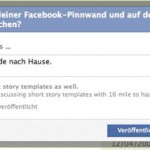 Facebook has a ‘Like’ change on the German website Heise, wherein the Facebook Like buttons on the site are changed. The new look of the ‘Like’ button is in a locally-hosted greyed-out image which transforms into the actual Facebook Like button once a user clicks on them. This means that on Heise, the Facebook buttons would not be activated by default. If one does not click on it for the first time, Facebook will not be able to track one’s visit on Heise.
Facebook has a ‘Like’ change on the German website Heise, wherein the Facebook Like buttons on the site are changed. The new look of the ‘Like’ button is in a locally-hosted greyed-out image which transforms into the actual Facebook Like button once a user clicks on them. This means that on Heise, the Facebook buttons would not be activated by default. If one does not click on it for the first time, Facebook will not be able to track one’s visit on Heise.
The procedure after the first click is simple as Heise would perform an AJAX call which then inserts the Facebook Like button dynamically. Once the insertion is done, Facebook scripts which are necessary would load and the required transmission of the usual data Facebook is done.
Talking about the change made by Heise, one would have to click on the Like button twice. This has a hidden advantage which would let the loading of a specific page to be faster slightly as before. However according to Heise, there is still an option for a visitor to let the working be like it was before and to turn on the Like button by default, but they then would have to deal with the consequences.
To no one’s surprise, Facebook wasn’t happy with the change as its spokesperson quoted to the German publication that the way the Facebook Like button has been implemented, the Facebook Platform Policies have been violated. The spokesperson even specified this clause:
8. You must not use or make derivative use of Facebook icons, or use terms for Facebook features and functionality, if such use could confuse users into thinking that the reference is to Facebook features or functionality.

Whatever may be the case, the Facebook icon has been changed by Heise and as one can notice the change in the screenshot which is how the button looks on the website. Here one can even notice that there is on use of the actual Facebook logo too. However, if one wants to view what happens once the Facebook button is activated, the screenshot below would be detailed. This shows that when when the button is enabled, the official Facebook logo.

A similar noting can be seen even for Twitter and Google+ buttons. Bur there has been no reaction from these two social networking sites. On Heise’s part, it said that they had received more than 500 inquires in a span of 24 hours relating to the custom code it used in its implementation. The inquires included queries from TV stations and other media organizations.
This step of Heise might be a reaction to the declaration made by a German privacy group last month which noted that using the Facebook Like button would lead to profiling which indirectly infringes German and European data protection laws. Facebook on its part was in denial of any such allegations which stated that the Like button was not in compliance with EU data protection standards. It seems Heise has come up with its own middle-ground solution, which would keep its Facebook growth intact without any such alleged allegations.
There is still no clarity as to was Facebook fine with the new image or not. It had shown its reactions to the new way adopted by Heise for the Like button, but the image might again be a concern from Facebook’s side. The response from Facebook on this particular point is awaited.


